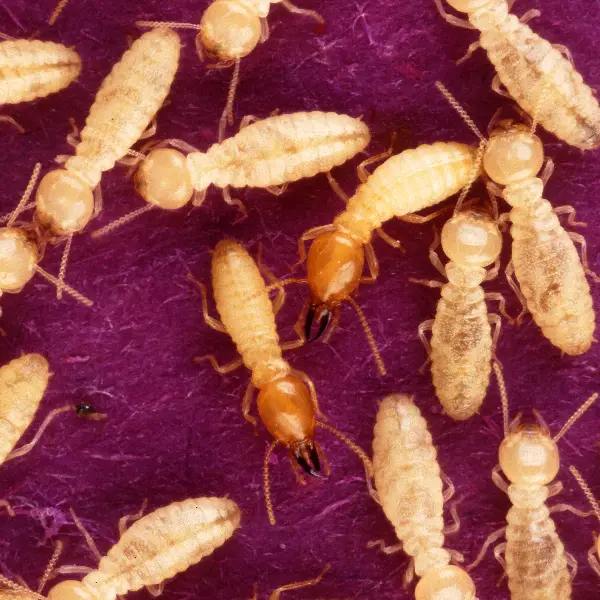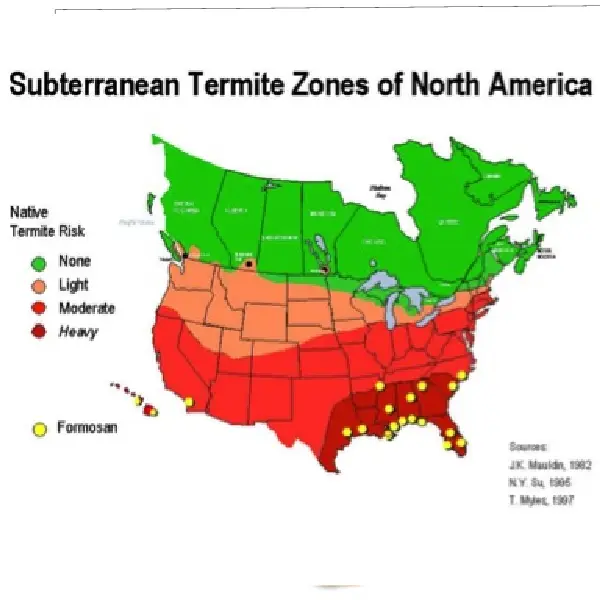Everything About Termite Inspection

Termites genuinely want to turn your residence into a feast. They find everything to be quite delectable, including your walls, beams, flooring, decks, and so on.
Termite inspections: What are they? It is precisely what it sounds like; a search for termites and other creatures that damage wood within or around a home.
Stay with us in this post so that we walk you through the termite inspection, how it works, and when we get it done in the first place.
What Is a Termite Inspection?
An extensive assessment of a property to detect termites or signs of previous termite infestations is known as a termite inspection.
Termites are wood-eating insects that can seriously harm a home's structural integrity.
Every property owner should have a termite inspection, particularly before purchasing a home, in order to spot possible issues and take precautions to safeguard their investment.
Before you read further, you need to ask yourself if you know anything about pest inspection. If you do not have particular information about it, click on the article pest inspection to find out.
When Should I Get a Termite Inspection?
The following lists the appropriate times for a termite inspection:
- Prior to purchasing a house
- Once a Year or Less (particularly in high-risk areas): It's advised to get a termite examination at least once a year, even if you don't think there may be an issue; especially in regions where termite infestation is likely.
- Selling Your House: Prior to granting a mortgage to a prospective buyer, certain lenders can demand a termite examination.
- Identifying Termite Activity Symptoms: Get a termite inspection right once if you see evidence of termite activity on your own, such as mud tubes, discarded wings, or damage to wood.
- Following a Significant Moisture Event: Moist conditions draw termites.
What Do Termites Look Like?
Termites are gregarious insects that have clear caste structures within their colonies.
They resemble ants in certain ways, yet they may be distinguished from one another by certain unique characteristics.

image sourced from here
Termites are usually between 1/8 and 1/2 inches long, making them smaller than ants.
Depending on the species, their hue can vary, but generally speaking, they are light-colored, ranging from white or cream to light brown.
Termites have straight antennae and a rounded skull, in contrast to ants. Ants have bent or elbowed antennae.
Two equal-length sets of wings that extend past the body characterize swarmer termites, which are reproductive termites that leave the colony to form new ones.
They flapped their wings, then landed briefly. Both soldier and worker termites lack wings.
Of course, you can also use the WDO inspection to find out if any wood-destroying organization exists in your house. Click on the article WDO inspection to find out more about this inspection.
How Can You Distinguish Ants from Termites?
The size of ants varies greatly throughout species, however worker ants tend to be somewhat bigger than termites.
Termites typically have light colors, such as cream, white, or light brown. There is a greater range of colors available in ants, such as black, red, brown, and even yellow.
The thorax (midsection) and abdomen (back part) of termites are very little different from one another, giving them a wide waist. In contrast, ants' bodies appear segmented due to their well-defined, constricted waist.
Ants have bent or elbowed antennae, but termites have straight ones. Consider an ant as a bent straw and a termite as a straightened straw.
Ants and termites both have swarmers that depart from the colony to procreate. Their wings are different, though.
Two pairs of equal-length wings that extend past the body characterize termite swarmers.
They flapped their wings, then landed briefly. In their reproductive caste, ants have two distinct-sized wings: smaller hind wings and bigger front wings.
Early Signs of Termites in Home
The following early termite warning indicators will assist you in spotting a possible infestation before serious damage is done to your home:
- Termites with wings that leave the colony to breed are known as swarmers.
- Discarded wings: Termite swarming activity may have recently occurred if piles of discarded wings, usually of comparable length and size, are found next to windows, doors, or light fixtures.
- Mud tubes
- Wood that sounds hollow: Tap on any wooden surfaces in your house, especially the baseboards, walls, floors, and door frames.
- Surface flaws: Because termites consume wood from the inside out, impacted wood may exhibit surface cracks, paint that is blistering, or pinholes upon closer examination.
- Termite droppings, or frass, are little mounds of wood waste that are typically found close to termite activity.
- Termite damage can cause a building to deteriorate, resulting in drooping ceilings or uneven flooring.
Termite Inspection Checklist
Every homeowner should have a comprehensive termite inspection, but this is especially important when purchasing a house.
To help you through the inspection process, below is a checklist:
- Foundation: The inspector will check the foundation for termite access sites, fissures, and mud tubes.
For more information about the foundation inspection, click here.
- External walls: Look for damage, blistering paint, or hollow-sounding spots on the outer walls.
- Wood sources: Look for termite damage or indications of activity on decks, porches, fences, stacks of firewood, and any other wooden structures close to the house.
- Sources of moisture: Blocked gutters, poor drainage, or leaky pipes.
- Basements and crawl spaces are popular haunts for termites.
- Attics: Look for evidence of termite activity in attics, such as frass (termite droppings), abandoned wings, and damaged wood.
- The inspector will look for termite damage on walls, floors, and doors, such as uneven flooring, blistering paint, and hollow-sounding wood.
- Windows and doors are checked
Termite Inspection Report
The following items are mentioned in an inspection report:
- Inspection Basis and Scope
- Foundation: The walls of the foundation were checked for fractures, termite access sites, and the existence of mud tubes.
- External Walls: We looked for damage, blistering paint, and hollow spots on the external walls.
- Wood Sources: We checked for termite damage and indications of activity on decks, porches, fences, stacks of firewood, and other wooden structures close to the house.
- The inspector searched for places that had a lot of moisture, such as leaky pipes, incorrect drainage, or clogged gutters.
- Crawl Space/Basement (if applicable): Mud tubes, termite activity, and wood deterioration were all checked for in this region.
- Attic: Termite droppings (frass), abandoned wings, and harmed timber were examined in the attic.
- Walls, floors, and doors were examined for any signs of termite damage, such as uneven flooring, blistering paint, or hollow-sounding wood.
- Doors and Windows: The inspector looked for evidence of termite activity or damage on the frames around the doors and windows.
Termite Zone in Canada
Because of the harsh winters, termites are not a serious problem in much of Canada.

image sourced from here
Nonetheless, termite infestations are possible in a few isolated areas in southern British Columbia and southwest Ontario. Termites are thought to be a moderate to high risk in certain places.
- Southwest Ontario, which includes Toronto, Windsor, and Niagara Falls, and southern British Columbia, which includes Vancouver, Victoria, and the Fraser Valley, are regions with moderate to high risk.
- Low Risk: British Columbia and northern Ontario; the prairies (Manitoba, Saskatchewan, and Alberta); and Atlantic Canada (New Brunswick, Nova Scotia, Prince Edward Island, and Newfoundland and Labrador).
Prevention Tips
To prevent termites from invading your property, consider the following important preventive tips:
- Resolve faulty pipes and faucets
- To keep water away from your foundation, make sure the grading surrounding your home is appropriate.
- Handle condensation by controlling moisture levels in crawl spaces and basements with dehumidifiers.
- Keep a foundational barrier in place: Any wood parts of your house, including porches, decks, or fences, should have at least an 18-inch space between them and the ground.
- Employ pressure-treated lumber: Pressure-treated lumber is resistant to termite damage.
- Shift heaps of firewood: To prevent termites from using your firewood as a feeding source, store it at least 20 feet away from your home.
- Gaps and fissures in caulk: To stop termites from getting inside, regularly check the foundation walls and fix any gaps or fractures.
- Sweeps of windows and doors: To reduce possible access points, install weather stripping and door sweeps that fit tightly around windows and doors.
- Prune the branches of trees
- Clear the garbage and stumps
FAQs
How much does termite inspection cost?
In the US, termite inspections range in price from $75 to $325, with an average of $150.
How often should I schedule a termite inspection?
Both insurance and pest control firms advice arranging an annual check.
Can I prevent future termite infestations?
Yes, if you ensure that you regularly check your property for indications of termite activity. Keep an eye out for cracked timber, abandoned wings, and mud tubes.
How long does termite treatment take?
Typically, the course of termite treatment might take several hours to several days to reach its full completion.
Can termites survive in colder climates?
Although termites are typically thought of as being found in warmer temperatures, they may also live in colder areas. In order to adapt, they dig tunnels down below the surface, where the temperature is more constant.
Conclusion
If you are thinking about buying a new house, you should definitely think about termite inspection.
Termite inspection for home purchases is one of the most important jobs purchasers must ask for before buying a house.
The reason is, that termites and the signs of their existence might not be visible when you see the house. So we recommend you consider termite inspection before any decision.
- In this post:
- What Is a Termite Inspection?
- When Should I Get a Termite Inspection?
- Termite Inspection Checklist
- Termite Inspection Report
- Termite Zone in Canada
- Prevention Tips
- FAQs
- Conclusion



